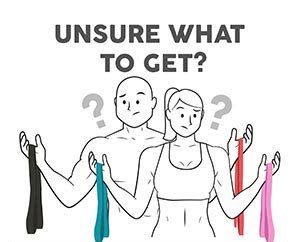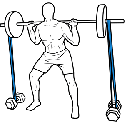Calisthenics Planche Grind
Everybody can plank. But what about the plank’s buff cousin, the planche? Chances are the answer is no (or yes, and I am a gymnast). It can be tough to know where to start with all theinformation floating about on places like Instagram. Gymnasts will practice something, and those practicing calisthenics will focus elsewhere. One thing that they can all agree on is that using resistance bands can open new doors in calisthenics planche training, especially for beginners.
Before we look at how resistance bands can up your planche game, let’s look at the planche itself and think about what needs to be strong to planche. Without making it too complicated, there are four aspects most people need to work on to bring themselves closer to their first planche:
1. The lean
2. Upper back strength and mobility
3. Shoulder protraction
4. Core strength and leg extension
Combined, the protraction (elevation and rounding of the scapula/upper back area) and the lean create a base of strength for the body to balance on while in a planche. If you have great protraction and a good lean, chances are you have a decent planche practice. Don’t worry if you haven’t got great protraction or lean yet, we’ll have a look at how to get the upper back moving better so it can move the way it needs to planche well. To make sure we aren’t missing out on any power, we must mobilise the shoulders and we strengthen them. If we can do this, the upper back becomes a strong and stable base, which makes it easier for the shoulders to hold your body weight and stay steady. Add in some core and back extension work to make those legs weightless and you’ll be well on your way to planching.
Now that we’ve looked at how a planche works, let’s look at why training with calisthenics equipment makes a difference. I spent six months doing exercises like wall walks (start in a high plank and walk up a wall into a handstand position and back down) and planche wall holds (push up position with your feet on the wall and hands as close to the wall as you can get them without falling on your face) and while they strengthened my shoulders and core, they weren’t teaching me what it really felt like to planche. I noticed this when I would practice my tuck planche and last only a couple of seconds.
In the last few months the bands have been making more and more appearances in my training, and the results have been noticeable. I found that I would lose my protraction the instant the planche became heavy, and as a result, I wasn’t really training those four aspects I mentioned earlier with the quality I needed to see improvement in my tuck planche. Doing more exercises with resistance bands has meant that I could focus on keeping my form and building my base, rather than struggling with the basics and seeing little improvement. It has also meant that I can work the basics of my straddle and full planche, even if they aren’t quite there yet. All you have to do is loop a band or two around either my ankles, knees or hips, based on the resistance of the band or how you are feeling, and there is planche practice getting you ready for the not-too-distant future.
“But that isn’t really a planche, then, is it?” You might say. Of course, it wasn’t — but it did make me realise that while strengthening my tuck is helpful, I needed to work on more than that if I was ever going to have a straddle planche. Flash forward a little more than two months and there I was holding consistent ten or more second tuck planche holds. Strengthening your banded straddle and full planche progressions will still definitely push your shoulders, protraction and core (core especially), meaning that your tuck planche can still easily reap the benefits.
Admittedly, it can be hard to know what exercises there are to do and how much and what you should be doing. That is why I am going to give you an example of one of my earlier banded workouts, which you can adjust, based on the level you are at by changing the thickness of the resistance band.
Warm Up:
1. Rolling Shrugs: 3 sets, 6 reps. Shrug your shoulders, roll them backwards and drop them slightly so they are in a half-raised position. Once you have found this position for 10 seconds, aiming to feel your lower, middle and upper traps all activating together. Make sure you keep your ribs tucked.
2. Band pull aparts: 2 sets, 12 reps. Grip a resistance band in both hands and pull your hands away from one another as if you were trying to touch your hands together behind your neck. Make sure your shoulders and ears stay as far apart from one another as you can manage, and make sure your arms stay straight throughout the exercise.
3. Scapular push up (kneeling or in a plank dependent on strength): 2 sets, 8 reps, hold each rep at the top for 2 seconds and aim to really protract at the top.
1. Banded push up with scapular protraction: 2 sets, 2 reps short of form failure. Loop an exercise resistance band behind your back and hold one end in each hand. Perform a push up by retracting the scapula, touching the chest to the floor and pressing back up to the original position. From here protract as much as you can against the band’s resistance. Stop 2 reps shy of your form breaking down, make sure these are all good quality repetitions.
2. Wrist conditioning: 2 sets, 15-20 reps each.
a) On hands and knees, place your hands under your shoulders. Now push all your weight into the base of your index finger and lift your palm as high off the floor while still keeping all your weight into the base of the index finger. Move the knees further back to increase difficulty. Maintain protraction throughout, and have your elbow pits facing forward.
b) Start on hands and knees. Make a fist and place the back of the hand onto the floor. If you cannot maintain the first, open the hand. From here, keeping your weight in the back of your hands, bring your chest to the ground, mimicking a push up. Ensure your elbows do not tuck into your sides, but stay around shoulder height throughout.
c) Standing, bring your hands to shoulder height, ensuring your arms stay straight. Make a fist and flick your fingers as hard as possible, as if they were wet and you can’t find something to dry them with.
The Street Workout:
- Banded Dragon Flags (negative or full): 3 sets, 5 reps. Put a band around a pole or an upright beam and loop it around your big toes (around full feet tends to move too much). Bring the ribs to the hips and the hips to the ribs as you lower.
1. Your current planche progression (unbanded): 5 sets, take a decent break between sets to ensure you have recovered as much as possible. If you aren’t yet able to tuck planche, use a band in a tuck planche to take some body weight.
2. Banded mountain climber holds: 3 sets, 10 reps, 3-5 second holds each rep. Loop a band around a pole or upright beam and loop the other end around your hips. Enter a high plank position (slightly bent at the hips to ensure you don’t lose your band) and bring one knee up to the inside of your elbow and hold it there for three seconds. Ensure you maintain strong protraction so that your hips flexors don’t dominate this movement. This exercise is especially important for beginners building their tuck planche.
3. A harder, banded planche progression. 5 sets. Ensure to vary where you put the band (hips, knees or ankles) and the progression you do (tuck, straddle, full or maltese). Aim to find a progression that you can do with good form for at least 5 seconds and for no more than 20 seconds. NB: My video isn’t a great example as my shoulders are flat, rather than properly protracted.
Planche leans: 2 sets, 10 reps. Start in a push up position and walk your feet forward so your shoulders are forward of your wrists. Walk yourself back to the push up position, and then back out into a lean. Hold your last rep for 5-10 seconds.
Keep grinding away at your planche and calisthenics game, and with time (and good form) it will come. Stay patient, stay focus, and stay banded.
Need a band? Turns out we have your back, and arms, and shoulders, and legs ; ) Just hop on over to our store.
Article written by: Joel Mullen
Acknowledgements: My inspiration, Cosmin Malita (@acrofitnessmotivation), my physiotherapist – Marcus Sabella, and my various teachers of planche: Clancy Gibson, Mike Makossa and Harry Williams (@holisticmovement), from whom I drew or adapted these exercises.



